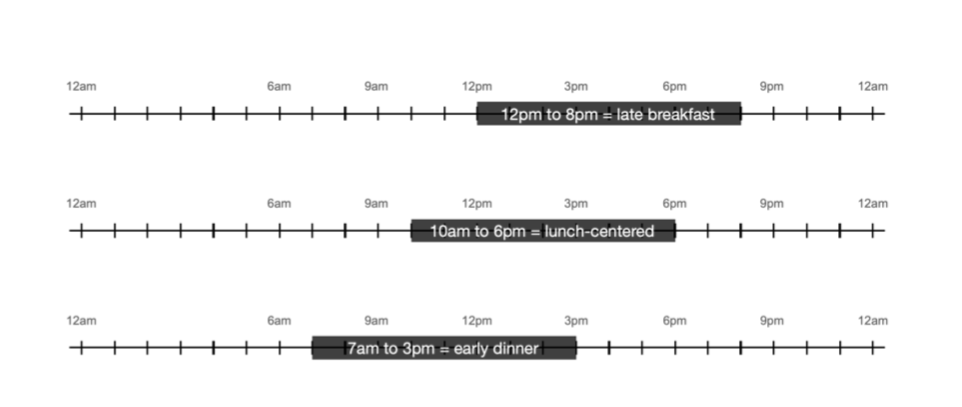If you search for “intermittent fasting,” you’ll most likely find a significant number of articles on the health benefits of intermittent fasting backed by positive research. But by narrowing it down to “intermittent fasting for women,” the results may come up a whole lot differently.
Where is this query—”Does intermittent fasting work for women?“—coming from, to begin with?
Discover whether intermittent fasting is suitable for women and how it’s different from intermittent fasting for men.
What is intermittent fasting?
Intermittent fasting is switching between fasting and eating on a regular schedule. The most common type of fasting is a 16-hour fast, also known as the Leangans protocol.
Typically, with this method, you skip breakfast and restrict daily eating to six hours. In other words, you have a 16-hour fasting window and an 8-hour eating window.
Other popular methods include:
- Eat-Stop-Eat: You fast for 24 hours. For example, you eat only lunch and then fast until lunch the next day. You can use this method once or twice a week.
- The 5:2 diet: You restrict your eating to 500–600 calories on two nonconsecutive days of the week and eat for five days as you usually do. Due to the calorie restriction, it’s called pseudo-fasting, as if you were fasting for 48 hours straight.
4 differences between intermittent fasting for women and men
In terms of the effects of intermittent fasting on women and men, female bodies respond to it differently. Here are the main differences between intermittent fasting for women and men:
Difference 1: Hormonal cycles
According to Miriam Gubovicova, a female health specialist and certified nutritional consultant, the main difference is between female and male hormonal cycles.
Women have a 29-day cycle, and men have a 24-hour cycle. It means that women in their reproductive years would experience intermittent fasting dramatically differently from men during their cycle.
“In the ovulation period, the female body prepares for conceiving a potential baby, so it brings about various hormonal changes,” she explains. “Essentially, intermittent fasting adds extra stressors to their bodies. On top of that, they may feel lower energy levels, mood swings, or hungrier than usual.”
Unlike men, who can reap all the benefits of intermittent fasting daily without dramatic changes in mood or energy levels, fasting for women can be counterproductive.
If they choose to, they shouldn’t fast before their ovulation period.
But post-menopausal and menopausal women, on the other hand, can balance their hormones with intermittent fasting in their bodies.
Difference 2: Glucose and insulin responses
This 2005 study investigated glucose and insulin tolerance in women and men in response to alternate-day fasting. They found that women had an insignificantly lower glucose response after three weeks compared to men.
But as for insulin tolerance, women had no change, while men significantly reduced their insulin response.
They concluded that alternate-day fasting might negatively affect glucose tolerance in nonobese women but not in nonobese men.
Difference 3: Metabolic response
From an evolutionary perspective, men and women respond to periods of scarcity differently.
According to this research, short fasting periods increase men’s metabolism by up to 14 percent. It also results in a significant increase in growth hormones.
As for women, the effects are the opposite—women’s metabolism slowed down as an evolutionary response to scarcity to preserve energy. What it suggests for women is that intermittent fasting isn’t as effective for fat loss as it is for men. But how valid is this suggestion?
Let’s look at the following differences:
Difference 4: Hunger hormone
Ghrelin, commonly known as a hunger hormone, is responsible for your…appetite! It is ghrelin that signals your brain to become hungry and search for food.
The higher it is, the hungrier you feel because its primary purpose is to make you consume more calories and store fat. On the contrary, the lower your levels, the fuller you feel. This is why lowering your ghrelin levels is a good idea for losing weight.
It turns out that 24-hour fasting has different effects on men and women.
In this study, researchers looked at ghrelin levels over three days of fasting in 33 participants and divided the results by gender.
Ghrelin gradually decreased in general in both men and women. It means that the longer they fasted, the less hungry they felt.
Surprisingly, female subjects showed a significant decrease in the hormone. Based on this data, women are likely to consume fewer calories per day than men, so it’s easier for them to keep the weight off.

7 benefits of intermittent fasting for women
Before we dive deep into the benefits of intermittent fasting for women, due to significant hormonal changes happening throughout the female hormonal cycle, it’s not recommended for:
- Generally healthy women in their reproductive years with low or normal BMI (or waist-to-hip ratio)
- Athletes
- Pregnant women or women trying to conceive
- Women with a history of eating disorders should avoid fasting
- Under age girls
With that being said, who can benefit from fasting?
Post-menopausal women, women with certain medical conditions, cancer patients, and overweight women can reap many benefits if they do it under professional supervision.
Intermittent fasting can also benefit women in their reproductive years, but only if they fast before ovulation.
So, what are the benefits?
1. Improves heart health
High blood pressure, high cholesterol levels, and high triglycerides are the leading causes of heart disease. By lowering all these factors, intermittent fasting improves your heart health.
However, more high-quality studies are needed to conclude the effects of intermittent fasting on heart health.
2. Lowers your risk of developing diabetes
It happens due to a notable decrease in insulin levels and insulin resistance that promote diabetes. In this 2011 study, six months of intermittent fasting reduced insulin levels by 29% and insulin resistance by 19% in overweight women.
3. Reduces inflammation
A number of human and animal studies suggest that intermittent fasting may reduce key markers of inflammation and oxidative stress.
4. Preserve your muscle mass
Unlike continuous calorie restriction, intermittent fasting can help you retain muscle mass. This benefit makes intermittent fasting for women over 50 even more significant.
The leaner the muscle, the faster the metabolism. So for women over 50 whose metabolism has slowed down, combining intermittent fasting with regular workouts can help reach weight loss goals with notable lean muscle retention.
5. Helps improve menstruation
Contrary to the most common belief that intermittent fasting can cause menstrual abnormalities, researchers of this 2013 study suggest that fasting may improve women’s menstruation cycles, fertility, and quality of life.
6. Improves brain health and cognition
Intermittent fasting has proven benefits for cognitive function. It helps you concentrate better, especially if you suffer from brain fog. It’s important to mention that it doesn’t cure the cause of it but rather helps you be more present.
7. Balances hormones
If you are a menopausal or post-menopausal woman, it can balance your hormones as your body resembles a more male body in terms of hormones.
What to watch out for
There are three main dangers of fasting: malnutrition, too much fasting, and fasting-mimicking diets. Let’s look at each one of them.
Danger 1: Too much fasting
Miriam explains that it’s already considered 12-hour fasting if you finish eating at 8 p.m. and have breakfast at 8 a.m. So pushing your first meal to 10 or 11 a.m. is already fasting too much, especially in the second half of your cycle. In general, women shouldn’t fast for more than 12 hours.
The danger of too much fasting is that you can easily lose weight to a level that will be detrimental to your health. On top of that, to make it sustainable, it should not consume your life. So you want to take it easy and listen to your body.
Danger 2: Malnutrition
If you choose to fast, you want to ensure you get enough nutrients within your two meals, according to your body type and lifestyle.
Often, women are told by various fasting ‘gurus’ that the only thing that matters is their fasting window, so they can eat whatever they want during the feeding window. Not only does it defeat the purpose of fasting, but it also can lead to malnutrition and causes serious health issues.
— Miriam Gubovicova, female health specialist and certified nutritional consultant
Ronan Diego, head of Health & Fitness at Mindvalley and trainer of Mindvalley’s Beyond Fasting Quest, adds, “When you consume little calories during your eating window, it can disrupt your hormonal and reproductive systems. So when you fast, fast. When you eat, you should eat to satiation.”
Danger 3: Fasting-mimicking diets
Intermittent fasting is a booming trend, so there are fasting-mimicking diets selling products claiming to make fasting easier. These supplements can lead to malnutrition, so you should avoid such promising shortcuts.
Ronan explains that amenorrhea and other menstrual abnormalities happen when women have an aggressive, sustained caloric deficit equivalent to malnutrition, with or without fasting. So it’s not fasting itself that can cause this condition, but an aggressive caloric restriction.
Women who have tried intermittent fasting and experienced amenorrhea either fasted for too many hours for an extended period or malnourished their bodies when they weren’t fasting.
He adds, “When you consume little calories during your eating window, it can disrupt your hormonal and reproductive systems. So when you fast, fast. When you eat, you should eat to satiation.”
Getting started with intermittent fasting
So, where should you start your intermittent fasting journey? Here are some tips to help you start it and stick with it.
1. Find your balance
Ronan explains that you want to achieve balance when you do it daily. He compares it with an airplane that goes steadily up to reach an altitude above the clouds.
Once it reaches altitude, it becomes stable, which allows it to fly faster. So just like an airplane has its cruising altitude, you want to find your sweet fasting window spot and get there gradually.
On average, it’s a 16-hour fasting window, so you want to take a week to reach it before you do your full 16-hour fast.
2. Decide on your feeding window
Depending on how flexible your daily schedule is, choosing the most suitable feeding window is key. You want it to support your eating hours instead of disrupting them.
There are three types of feeding windows:
- Late breakfast is when you push your first meal to later hours—you literally break your fast. It’s the most suitable type.
- Lunch-centered is when you eat at around 10 a.m. and finish your last meal at 6 p.m. This is the most convenient type.
- Early dinner is eating your first meal early in the morning and then having your last meal in the middle of the day. If you have a flexible schedule, opt for an early dinner, as it will maximize the benefits of fasting.

3. Eliminate unwanted stressors
Fasting acts as a hormetic stressor on your body, triggering an evolutionary mechanism termed hormesis. When we experience mild stress, we can easily recover from it and get stronger and more resistant to higher doses of stress.
Men and women have inherent metabolic and hormonal differences, and it’s evident that these differences determine how we respond to a stressor like intermittent fasting.
The female body is generally more complex and susceptible to stress than the male body. So when you start your intermittent fasting practice, it causes additional stress on your body, leading to a compound effect.
Addressing unwanted lifestyle stressors will help you make the most of your intermittent fasting.
Make the best out of your intermittent fasting
So, should you try intermittent fasting as a woman? And if you should, which method should you choose?
To succeed with intermittent fasting for fundamental transformation (not a temporary change), you need to understand your goals for your health and body and find what works best for you.
This is what Beyond Fasting Quest is all about—it will help you gain clarity and provide a variety of techniques and recommendations.
Most importantly, it will teach you how to make a clear choice that matches your long-term vision for your unique female body.









